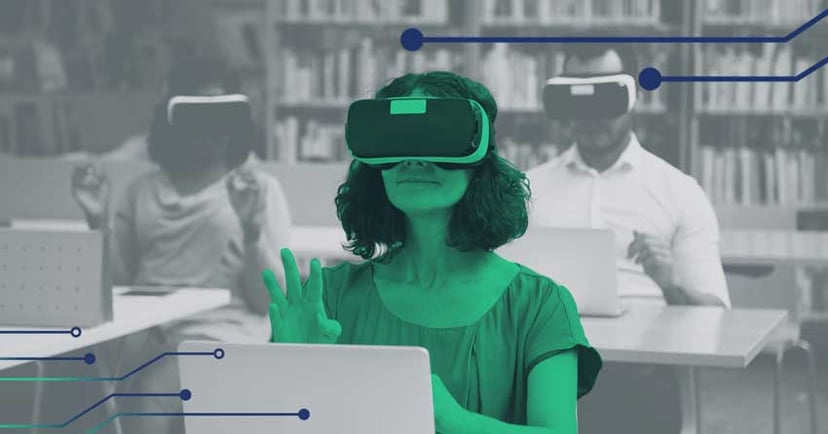High-tech innovation has transformed higher learning, from the lecture hall to the library and beyond
Because it has touched so many areas of our lives over the past several years, it’s tempting to attribute just about everything to COVID-19. This is especially true where the adoption of technology is concerned. Seemingly unrelated developments were adjustments made to address the needs of living in the pandemic era. Consider the resurgence of the QR code in the hospitality sector, or the widespread shift to remote work.
Naturally, the pandemic has had an effect on higher education as well. In reality, colleges and universities were already becoming increasingly high-tech institutions, from the classroom to the academic library and beyond.
As technologies like augmented and virtual reality (AR/VR) and artificial intelligence (AI) become more common, this trend will not likely slow down anytime soon.
See also:
- The impacts of advanced technology on libraries and education
- PressReader has content for everyone, even the kids.
- Is hybrid the future of the event industry?
Let's look at the significant impact technology in education has had on the ways students learn and teachers teach, and how academic libraries have found innovative ways to provide students with quality educational content.
Education technology is a big business
According to a report from McKinsey & Company, the number of users of massive open online courses (or MOOCs) increased from 300,000 to 220 million between 2011 and 2021.
Between 2012 and 2019, the number of hybrid and distance-only students at traditional universities in the US increased by 36%. When the COVID pandemic hit in 2020, that growth accelerated rapidly by an additional 92%.
As online and remote learning have grown, educational technology (or edtech) has become a big business. According to a report from HolonIQ, venture funding for edtech in the US grew from $1 billion to $8 billion between 2017 and 2021.
McKinsey notes that “Edtech investment could be poised for more growth as online offerings surge and as institutions continue to shift toward blended learning grounded in cutting-edge digital technologies.”
The future is online
According to a 2021 report, students at higher-learning institutions in North America, Europe and Australia said they expect half of their coursework will be available online in the future. Nearly two-thirds of the 1,128 students surveyed expected future classes to have at least some online content or feature, either as online or hybrid courses. In the same report, 46% of 1,076 staff surveyed anticipated more remote work in the near future and 54% said they prefer hybrid courses.
While many students have become used to online learning and hybrid courses, most would not want their education to be virtual-only. In fact, only 21% of survey respondents said they would prefer taking all of their classes online. Fewer than one in five students in Australia, France, the Nordic countries and the UK preferred an all-digital education.

Taking a hybrid approach
Various technologies allow for a hybrid approach to learning, with some students in the classroom or lecture hall and some joining in remotely. These include downloadable interactive software platforms that students can access from their own phones, computers and tablets. Using these communication and collaborative learning tools, learners can ask questions, share ideas and attend breakout discussions in real time.
Outside of class time, there are also apps that give students 24-hour asynchronous access to recorded lectures and expanded instructional materials. Using their own smart devices, students can learn at their own pace, logging in from home or their favorite coffee shop.

Interactive lessons in a virtual classroom
The idea of a network of online virtual worlds dates back to at least the 1990s. Only recently, however, has “metaverse” become a buzzword in the business and tech worlds. We have Facebook founder and CEO Mark Zuckerberg to thank for that.
Last year, Zuckerberg announced that his company would change its name to Meta Platforms. The rebranded company would focus on building a platform that users can access via VR headsets and augmented reality. “We believe the metaverse will be the successor of the mobile internet,” Zuckerberg said at the time. “We’ll be able to feel present—like we’re right there with people no matter how far apart we actually are.”
These technologies could transform education; think of the possibilities of teachers delivering interactive lessons in a virtual classroom.
Innovative ways to increase student engagement
These new tools can also increase student engagement in the long term — not just in online learning, but also in the real-world classroom.
The right education technology can enable learners to connect and engage in collaborative learning with other students and empower them to take charge of their own learning process. It can also give teachers the tools to design lesson plans that can personalize learning based on the needs of each student.
-
Personalized learning via AI adaptive course delivery. Teachers can customize cloud-based, AI-powered interactive software, which adapts educational materials to individual learners’ abilities and subject knowledge for truly personalized learning.
-
Augmented reality/virtual reality. Special VR headsets and software can immerse students in laboratory simulations, virtual museum tours and other interactive content. AR requires less specialized equipment; the software can be run on most mobile or laptop devices.
-
Chatbots. Powered by machine learning, these teaching assistants can provide answers to students’ questions. They can also explain course content outside of class time. The most sophisticated bots can also save instructors time by creating and even grading assignments and exams.

Consuming content in the digital age
Think about the way you consume content through the course of your day. Maybe you lean on the ways of previous decades, savoring your morning latte with a copy of the daily newspaper spread out in front of you — and perhaps a vintage vinyl copy of Fleetwood Mac’s Rumours spinning on the turntable.
If you’re like most of us, though, digital devices play an increasingly important role. Perhaps you keep up with the news by scrolling Twitter and catch up with friends on Facebook. You likely discover new music on Spotify, and wind down at night with a good read on your Kindle.
If you’re a college student, you probably rely on online sources for much of your research, whether it’s sifting through the archive of journals on the Oxford Academic platform or looking for breaking news headlines.
Librarians saw it coming
When we at PressReader published our first report on the future of libraries in 2019, we noted that there’s been a dramatic change in the way people discover and access content — whether it’s videos, music, news media, or peer-reviewed journals.
The COVID-19 pandemic certainly accelerated this change, but academic librarians have seen it coming for years. In 2012 an OCLC (Online Computer Library Center) study found that librarians at educational institutions predicted this shift. According to the study, most thought students and staff would move toward using the library to access information and educational resources online rather than borrowing print books.

Are academic libraries still relevant?
Internet connectivity is a powerful tool, but it presents traditional education institutions with new challenges. If the world’s knowledge is within reach of anyone with a keyboard, do students really need libraries the way they did decades ago?
We first asked this question in 2019. Citing a study by the Association of College and Research Libraries, we concluded that the resounding answer is, “Yes!” That study, based on four years of research, suggested that there is a positive correlation between the use of an academic library and a student’s success.
How libraries help students learn
The positive impact that library use has on students is particularly apparent in a few key ways:
-
Use of academic library spaces relates positively to student learning outcomes, retention and success
-
Library instruction adds value to a student’s long-term academic experience, and according to the study, helps shift students’ research behavior from searching the web to exploring library resources
-
Libraries also promote academic rapport and increase student engagement
To continue providing these benefits, university libraries must continue to adapt to the changing needs of users. This includes the way they consume content and seek out research materials and educational content. Libraries are compelled to keep pace with students' own technology use. A growing number of students prefer to access library resources on their own laptops, smartphones or tablets.
Designing for the next generation of students
Evidence suggests that the days of the campus library as an “Information Commons” complete with rows of desktop computers for student use might very well be in the past at many schools. Steven Bell, Associate University Librarian at Temple University, addressed this topic in a recent article he wrote for the nonprofit EDUCAUSE.
“The challenge facing academic librarians, whatever the age of their building and its technology infrastructure, is whether they will be able to keep pace with the technology sophistication and expectations of the incoming and next generation of students,” Bell observed.
Bell noted that academic libraries being designed and built, or renovated, today should be envisioned as spaces that must serve all those who will inhabit the buildings far into the future.
“The desktop computer lab is but one legacy technology that was an essential component of academic libraries at the dawn of the age of personal computing,” Bell wrote. “Although desktop computers are hardly an obsolete technology, mobile devices are simply the technology of choice on campus today.”
We still need librarians
Even as machine learning gets more advanced and the borders between the real world and the metaverse become blurrier, librarians are just as important as they have ever been — even if their role is evolving along with the digital tools.
Futurist Ray Kurzweil foresaw much of what we’re witnessing now almost 30 years ago. In March of 1993, Kurzweil wrote a column for Library Journal called “The Changing Library”. In it he talked about what the library of the future might look like.
Technology can't match human intelligence
“With books in virtual form, transmitted readily through the communications ether, the emerging virtual library will not need to be housed in a building,” Kurzweil wrote. “Computers will continue to facilitate the efficiency of administration, but this human-directed function will not go away.
“The last two categories of library service — knowledge finding and pedagogy — will become the primary focus of the librarian. Although computers will provide competition in these roles, until computers are capable of matching our intelligence, the role of humans in the process of managing and imparting knowledge will remain central.”

Libraries can be a technology touchpoint
Indeed, librarians can make it easier for users to find the digital content they are looking for and gather relevant information.
Earlier this year, PressReader issued a follow-up report on the future of libraries. In that report, Keith Thong noted the opportunities libraries have to be the first touchpoint for users accessing new tools. (Thong is the president of the Malaysian Booksellers Association.)
“Artificial intelligence–assisted learning and assessment is widely deployed now,” Thong said. “A library may even be a mock-test center where one can do preliminary tests using AI. And then you have learning resources using AI that are made available.”

Remote access to content
Our most recent report noted that many libraries are also investing in digital content licenses and tools to offer remote access to library content. This technology is not outside the scope of the typical academic library budget.
António Torres is the CEO of Portugal’s WECUL Consulting Agency. “The affirmation of these digital reading methods, which imply changes in reading habits and reaching new audiences for reading, is a way forward for libraries,” Torres told us.
“Libraries have already seen a greater demand for them, in recent times, due to the pandemic situation,” Torres said. “These platforms even offer coverage of content in the local languages of the countries, far beyond the English language content, which is already more available.”

Technology for changing times
Academic-library users have a wide variety of needs, and librarians must be prepared to meet all of these. Students and other library patrons require tools that will empower them to access the right information to enable their research or academic work — and they count on that information being accessible and up-to-date.
Libraries that offer PressReader can provide students with access to more than 7,000 high-quality newspapers and magazines from around the world. These publications cover topics that range from business, science and technology to art and design, and beyond.
PressReader offers content from more than 120 countries in over 70 different languages. This enables students from all over the world to stay connected to what’s happening locally and back home.
More change lies ahead
Education technology has the potential to further transform academic institutions. It has also forever altered the way that students, teachers and other users think of those institutions’ libraries. Speaking of libraries in general, be they academic or public, Juanita Thacker predicted that further digital transformation lies ahead.
Thacker is the Director of Marketing at WOC+Lib. She told PressReader: “Electronic subscriptions and e-book spending greatly outpace that of print materials in libraries. I see that continuing to grow in the future. The library’s continued presence and existence quite literally depends on technology.
“To that end, I can see library workers at all levels across departments becoming more tech-savvy in response to the changing times,” Thacker concluded.









